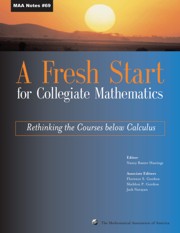Book contents
- Frontmatter
- Preface
- Contents
- Introduction
- Background
- Theme 1 New Visions for Introductory Collegiate Mathematics
- Theme 2 The Transition from High School to College
- 13 High School Overview and the Transition to College
- 14 Precalculus Reform: A High School Perspective
- 15 The Influence of Current Efforts to Improve School Mathematics on the Preparation for Calculus
- Theme 3 The Needs of Other Disciplines
- Theme 4 Student Learning and Research
- Theme 5 Implementation
- Theme 6 Influencing the Mathematics Community
- Ideas and Projects that Work: Part 1
- Ideas and Projects that Work: Part 2
13 - High School Overview and the Transition to College
from Theme 2 - The Transition from High School to College
- Frontmatter
- Preface
- Contents
- Introduction
- Background
- Theme 1 New Visions for Introductory Collegiate Mathematics
- Theme 2 The Transition from High School to College
- 13 High School Overview and the Transition to College
- 14 Precalculus Reform: A High School Perspective
- 15 The Influence of Current Efforts to Improve School Mathematics on the Preparation for Calculus
- Theme 3 The Needs of Other Disciplines
- Theme 4 Student Learning and Research
- Theme 5 Implementation
- Theme 6 Influencing the Mathematics Community
- Ideas and Projects that Work: Part 1
- Ideas and Projects that Work: Part 2
Summary
Editor's note: This paper is the text of an invited address given by Zalman Usiskin, in October 2001, at the conference Rethinking the Preparation for Calculus. (Please see the paper about the conference, by Jack Narayan and Darren Narayan, in the introduction to this volume.)
Introduction
I have been asked to present a “high school overview” with some comments about the transition from high school to college. I am interpreting the first part of this mission to mean an overview of the mathematics curriculum in schools, instruction in classrooms, and performance among students today in the United States. Six years ago at the conference “Preparing for a New Calculus” I concentrated mainly on the curricular changes moving into grades 7–12 [13] and could only begin to speculate on the implications of those changes. Now we have some rather consistent information about changes that have occurred in student exposure to and learning of mathematics.
Any overview is an oversimplification. The word “precalculus” itself can refer either to the student's mathematical experience before taking a calculus course, or to the specific concepts felt to be prerequisites for calculus. Students, teachers, the mathematics curriculum itself, the broader school context, and the surrounding community vary widely. Furthermore, we lack some important data that might help us to understand what is going on. In particular, we lack data on what works and what does not. But we do have some trend data and some specifics that may help inform discussion of these issues.
- Type
- Chapter
- Information
- A Fresh Start for Collegiate MathematicsRethinking the Courses below Calculus, pp. 111 - 120Publisher: Mathematical Association of AmericaPrint publication year: 2006
- 2
- Cited by

